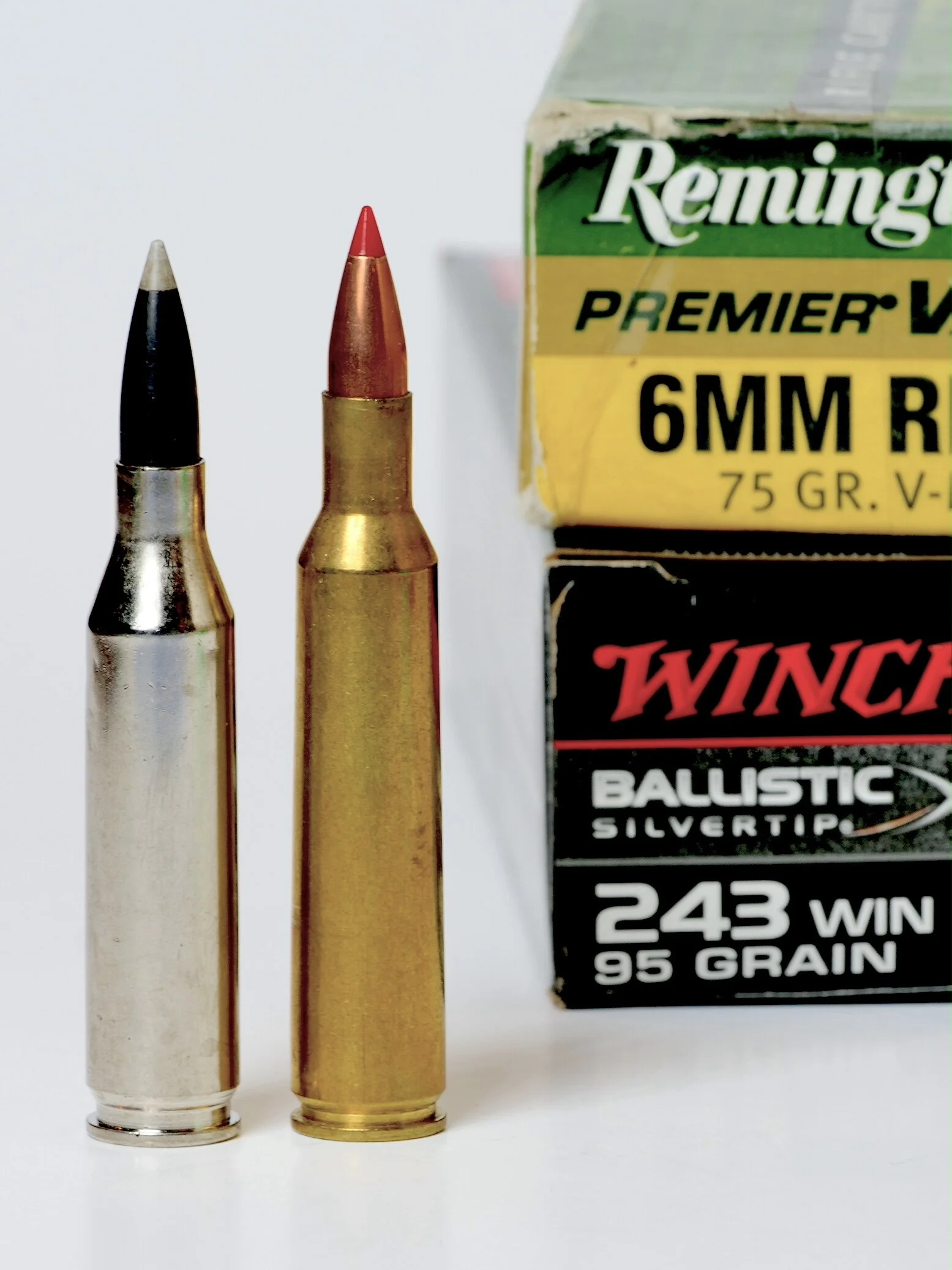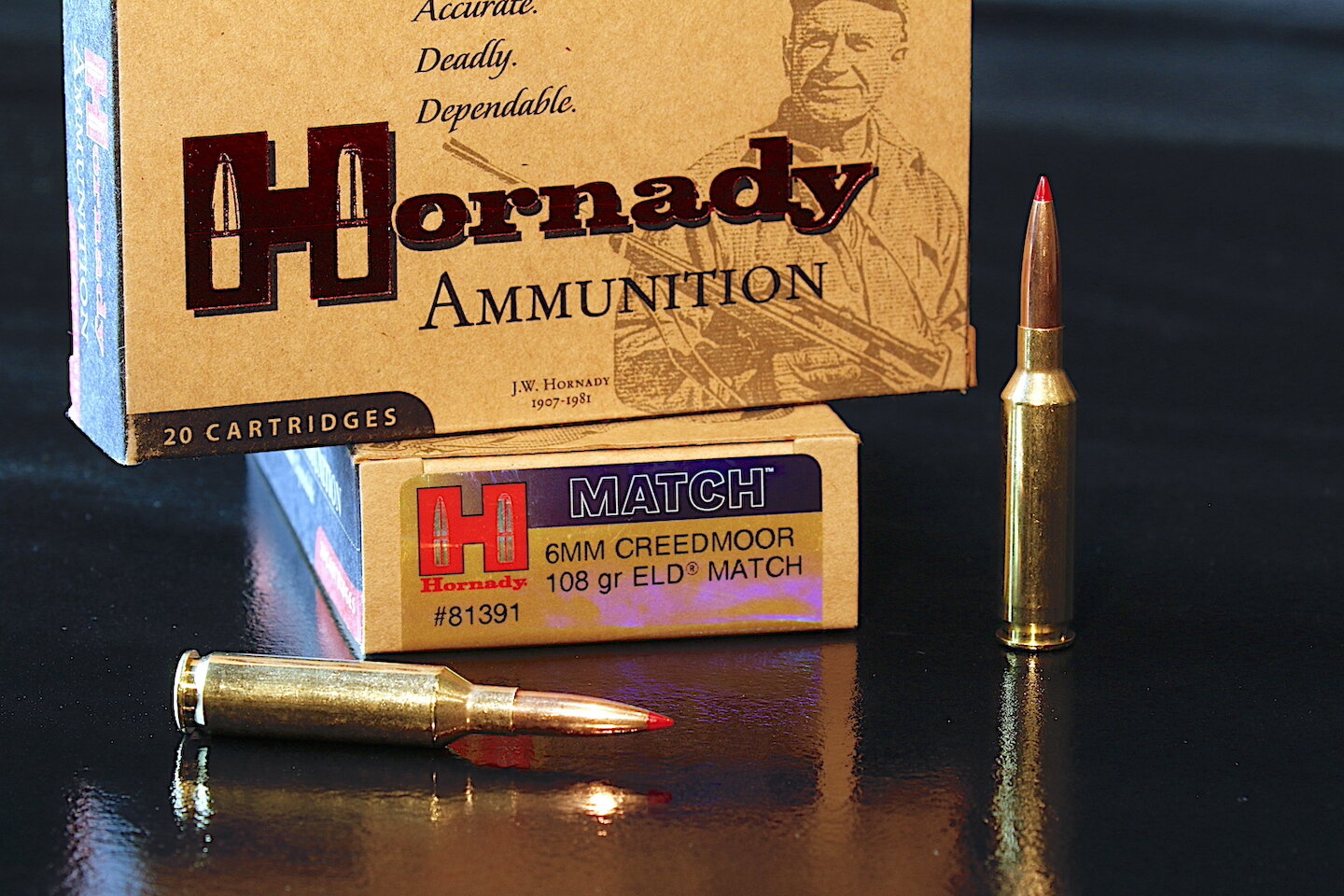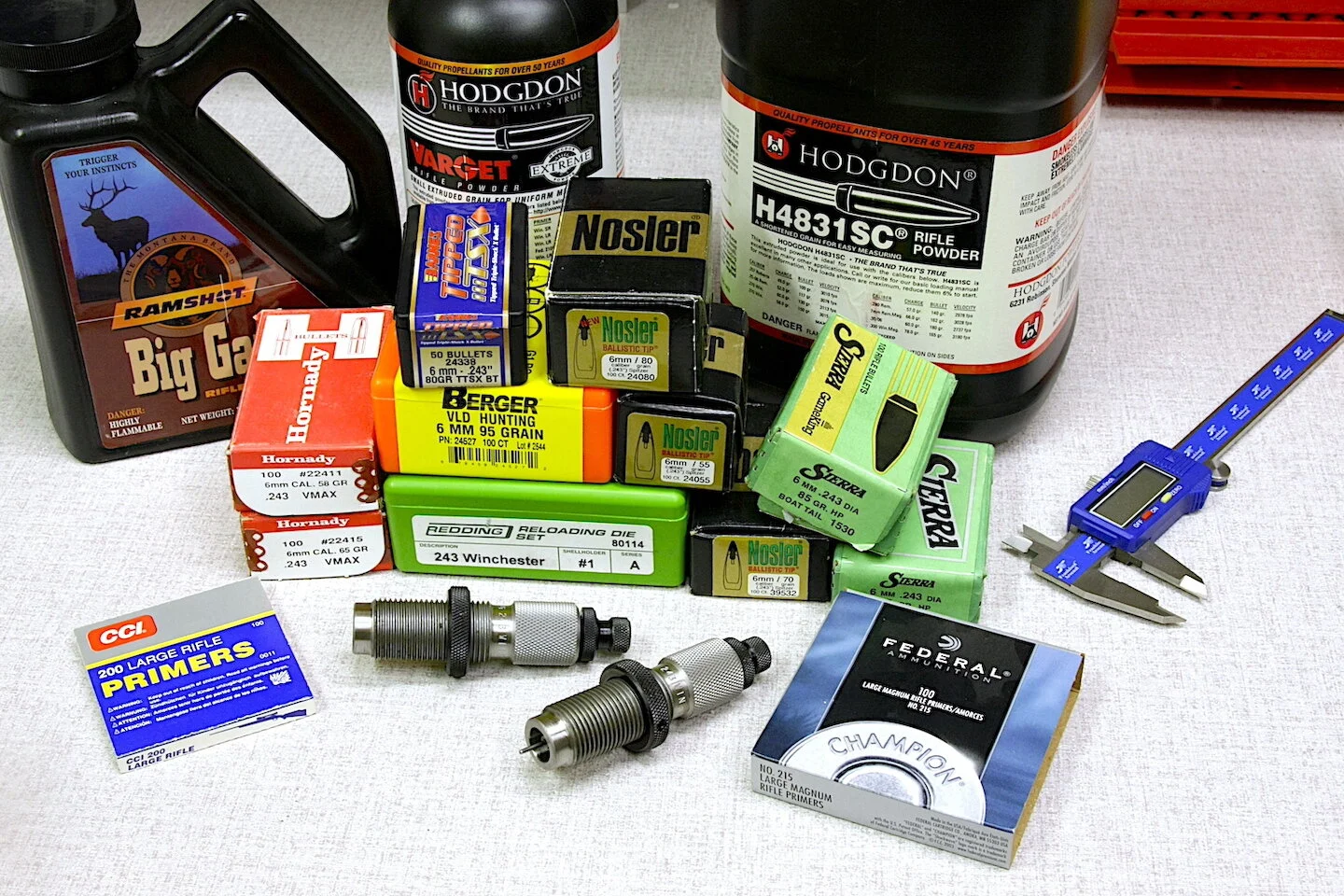How 243 Winchester Trumped the Superior 244 Remington
Winchester’s 243 and Remington’s 244 both came out in 1955 just like McDonald’s and Disneyland and just before Elvis hit the big times with Heartbreak Hotel. Notice the sharper shoulder and longer neck on the 244/6mm Remington.
Everyone loves an underdog. But that’s not why the 243 Winchester buried the faster 244 Remington which now races under the banner of 6mm Remington (the third title of its career.)
Oh yes, my friends, the often renamed 244 Remington is the ballistic winner of this race. But the 243 has locked up the popular vote — for the past 65 years and counting. The only questions now are can the 6mm Remington finally challenge the champ and will the 6mm Creedmoor sweep both into the dustbin of history?
If you like classic tales of cartridge history, you’ll love this one. Most boomers have heard it if not lived it, but younger shooters and hunters may have have missed all the fireworks. After all, these days the 6mm Creedmoor has entered the 6mm race and is stealing the limelight from the venerable 243 Winchester. Heck, the 6mm Remington should have done that in the 1960s.
The new 6mm Creedmoor, ballistically a twin to the 243 Winchester, is the 21st century, fast-twist version of 1955’s .243 duo.
Our Story Begins…
Here’s the scoop: It was 1955. Disneyland opened in California and so did the first McDonald’s. Some kid named Elvis was singing on the radio. WWII America was booming and trying to put the horrors of fascism in the rearview mirror. Businesses were booming and so were maternity wards. A strong middle class was finally making good money, good cars, smooth highways, new appliances, new fun. Rockets were inspiring dreams of lunar travel and jets were routinely breaking the sound barrier. Things were moving fast, rifle cartridges included.
While the big gun-and-ammo companies were selling 30-06s and 270 Winchesters, few high velocity deer hunting cartridges were on the market. Most deer hunters prowled the woods with 30-30s, 32 Winchesters, 35 Remingtons or 300 Savages. Roy Weatherby was showing the way with his 270, 257, 7mm and similar magnums, but they were proprietary and the typical blue-collar family man couldn’t justify the expense.
In 1955 the 250 Savage and 257 Roberts were the best light caliber, dual purpose rounds for deer and varmints. There were no American 6.5s. The only 7mm besides Weatherby’s hot-rod was the European 7x57 Mauser. The 308 Winchester has only appeared three years earlier. The 25-06 Remington, 264 Win. Mag., 284 Winchester, 280 Remington, 7mm Rem. Mag., 300 Win. Mag. were all waiting to be born.
Wildcatters were filling the void with a confusing mix of modified 30-06, 7x57, 30-30, and 300 H&H cases. One of those experimenters was Fred Huntington of RCBS who necked the 257 Roberts down to grip a .243” bullet, gave it a 32-degree shoulder, and called it the 243 Rockchucker. Another was Warren Page, shooting editor of Field & Stream. He’d been messing around with one of the early 308 Winchester-style cases that came out of the military’s T65 research program, calling his creation the 243 Page Pooper.
Winchester necked down its new 308 Winchester to make the 243 Winchester while Remington based its 244 Remington on the 7x57 Mauser case once removed via the 257 Roberts. It is the 7x57 shown here. Note the steeper shoulder and longer neck of the 244 aka 6mm Remington. By today’s standards it could use straighter sidewalls.
Winchester followed Page’s lead and necked its 1952 308 Winchester down to .243, but gave it a shorter neck and more sloped shoulder than Page’s wildcat. Remington struck back the same year by legitimizing Huntington’s Rockchucker as the 244 Remington. The race was on.
Why The 244 Remington Had the Advantage
From our Monday morning quarterback position is would seem the 244 Remington had the upper hand. For one thing, it was chambered in Remington’s relatively inexpensive, true short-action M722. Winchester’s 243 had to be run through its more expensive, standard-length Model 70 with a magazine block for handling the shorter cartridges. Secondly, the 244 Remington title had to have resonated with American shooters better than the odd 243. Cowboy movies and TV shows were all the rage and everyone was familiar with the 44-40 Winchester, the 44 Smith & Wesson and a dozen other 44-caliber rounds. Icing on the marketing cakes was the hot new 44 Remington Magnum which was also released in 1955. Third, the 244 Remington was cleared by SAAMI for max chamber pressure of 65,000 psi while the 243 Winchester was throttled to just 60,000 psi. Fourth, the 244 case held about 2 grains more powder and pushed the same weight bullets about 100 fps faster.
By all appearances this was a horserace, but the Remington clearly had the advantage.
So the Winchester won.
Yes, crazy as it sounds, within just a few years 243 Winchester sales were handily beating 244 Remington’s. To this day the 243 Winchester is one of the top 10 selling cartridges in the USA. Virtually every gun maker in the world chambers it. The 244 Remington? Gone. Well, sort of. Here’s the rest of the story.
Why the 243 Winchester Won
A sweet little Browning X-Bolt in 243 Winchester anchored this splendid New Mexico pronghorn instantly with a low neck/high brisket shot, the 95-grain Winchester Ballistic Silvertip powering right over the heart. A light, trim little Swarovski Z3 3-10x42 directed traffic.
Soon after these fierce competitors hit hardware store shelves, hunters noticed they could buy 75- to 100-grain bullets in the 243 Winchester, but no heavier than 90-grain in the 244 Remington. Winchester was advertising it sexy new “little 24-caliber” as light-recoiling, hyper-velocity switch hitter suitable for everything from farm varmints to deer. Remington was pushing its 24-caliber as the ultimate coyote, fox, and woodchuck round. Pasture rodents beware! But, of course, the 90-grain bullets would take care of deer, too…
Now, we have to remember that in 1955 deer hunters were hooked on calibers of .30 and larger throwing bullets of 150-grains and heavier. Those were considered fairly light given the previous generations’ reliance on even larger calibers and heavier bullets. The 250 Savage and 257 Roberts were proving themselves as effective “light-caliber” deer/varmint choices, but they could drive 120-grain bullets. Sliding down to 100-grains was one thing, but 90? Apparently that was a bridge too far. Hunters balked.
So why didn’t Remington just offer them some 100-grain 244 loads? Because of their rifle’s fatal flaw — 1-in-12 twist rifling. The twist was too slow to reliably stabilize all 100-grain spire-point bullets of the day. Handloaders had a few 95- and 100-grain round nose bullets that would work, but those sacrificed the downrange energy advantage of the spire points.
Initially 244 Remington loads were offered with 75-grain and 90-grain bullets. Deer hunters weren’t impressed.
It’s difficult to ascertain if there were also some issues with Remington’s 90-grain deer bullet aside from weight. Was it perhaps too frangible? Was it failing to penetrate and kill quickly? I doubt that, given the dramatic, quick-killing smack of 75- to 85-grain .243 varmint bullets I’ve witnessed over the years. More likely the rumor mill was churning, probably ignited by a popular gun writer or two and fueled by the grapevine.
The “grapevine,” for all you digital wunderkinds weaned on social media, was a primitive vehicle of communication known as conversation. It happened at gas stations, feed stores, gun stores, cafes and bars. (Especially bars.) These were buildings in which goods were displayed and sold to people who walked in and not only looked at, but handled those items, speaking with not only clerks and store owners, but other shoppers perusing the wares. Nearly everyone read the three or four outdoor magazines of the day plus a local newspaper or two in which something called an “outdoors” editor would write about socially acceptable avocations like hunting, shooting, and handloading. One discouraging word from a writer like that could be the kiss of death for a cartridge.
Regardless how the message spread, hunters avoided the 244 Remington in droves. In response, Remington in 1958 quietly increased the twist of its 244 rifles to 1:9. But nobody noticed. (When was the last time you spotted the twist rate of any rifle?)
Remington Fights Back — Poorly
Given steady and heady performance of the 243 Winchester on virtually everything, sales of it soared. The 244 Remington sank. So in 1963 Big Green had another of its brain storms. They would introduce a new cartridge. The 6mm Remington Magnum, a hot new 24-caliber that spit 100-grain bullets 100 fps faster than the 243 Winchester! (It was the 244 Rem. in a 1:9 twist barrel.) Nice try guys, but too late. Quickly erasing the Magnum part of the title didn’t change anyone’s mind, either. Not even chambering the 6mm in the new, wildly popular Model 700 rifle could turn the tide.
The author’s wife had no trouble hitting this heavy Wyoming pronghorn despite the 1:12 twist barrel on this custom M70 in 6mm Remington. It will stabilize no bullets longer than an 85-grain Sierra BTSP, but deer and antelope don’t seem to notice.
Today almost no one chambers for the 6mm Remington. More’s the pity because this cartridge truly is superior to the 243 Winchester. In addition to its higher pressure rating and larger volume, it sports a steeper shoulder (26-degrees to the 243’s 20-degrees) and longer neck (.351” vs. .241”.) According to current thinking, the sharper shoulder should improve the burn and reduce case stretching. The longer neck should enhance bullet-to-case concentricity, not to mention consistent seating tension, and minimize throat burning. And the 6mm’s 1:9 twist should stabilize even longer bullets than the 243’s 1:10 twist can handle.
But never mind. The 6mm Rem. is dead to all but nitpicking fanatics and handloaders who can appreciate its fine points. And even they may soon capitulate to the 21st century’s entry into the 24-caliber race, the 6mm Creedmoor.
Enter the Creedmoor — Should You Bite?
Oh dear. Legions of 6.5 Creedmoor haters are rending their shirts at the mere mention of Creedmoor. Sorry, but this new cartridge has all the bells and whistles demanded by the long range competition shooters currently driving cartridge and rifle development. It boasts the same case capacity of the 243 Win., adds the magical 30-degree shoulder and a .269” neck, is chambered in 1:7.5 twist barrels, and easily fits AR10 autoloaders.
Given its powder volume and 65,000 psi pressure rating, the 6mm Remington is the ballistic king of this trio. All fit short-action rifles, but the short, 30-degree shoulder case of the new 6mm Creedmoor — combined with its longer-than-caliber neck and 1:7.5 twist rifling platforms — suggests it will be the new 24-caliber darling moving forward. Nevertheless, handloaders with custom, fast twist 6mm Remington’s can not only play in its sandbox, but likely remain king-of-the-hill.
Does this mean you should choose the 6mm Creedmoor over the 243 Winchester? Or the 6mm Remington over both? Only you can answer that, but here’s what 50 years of shooting, handloading, and hunting with 243 Win. and 6mm Rem. cartridges have taught me: both are delightfully low-recoiling, deadly accurate, short-action 24-calibers suitable for precision shot placement on deer-sized game, coyotes, and hayfield rodents. The 6mm Rem. is a bit easier to work with on the loading bench, but I’ve never pulled my hair or even scratched it while working with 243 Winchester. No deer, pronghorn, nor coyote I ever addressed with either wished I’d used the other. Yes, 1:12 twist is too slow to stabilize 100-grain bullets. Even the 243’s 1:9 twist is insufficient for best accuracy with the new 105-grain and heavier, high B.C. bullets.
Rifles and ammo in 243 Winchester are much, much easier to find than 6mm Rem. If you opt to go the 6mm Rem. route, you’d better handload. You’d also be smart to get that 6mm in a 1:7.5 twist barrel. You’d then handily beat any 6mm Creedmoor without having to wear that title on your barrel. But if you find a used 6mm Rem, it should already have a 1:9 twist, so you’d likely be fine loading even 105-grain, perhaps 107-grain bullets.
243 and 6mm Speed and Performance Considerations
You can figure to shoot 100-grain projectiles 3,000 fps from a 24-inch barrel 243 Win.and 6mm Creedmoor, about 3,100 fps from the same tube in 6mm Rem. Handloaders might safely bump all those up 100 fps. In a 22” barrel, expect to lose about 50 fps with each. Good fur bullets for coyote calling are 55-grainers which can hit 4,000 fps with the right handload. I once saw one of these from a 243 Win. send a full grown zebra to that African paradise in the sky with one slap. It was a neck shot that hit the spine.
Handloaders can get the most out of any 24-caliber. Change that box of Redding dies to 6mm Remington and make that obsolete cartridge new again!
I’ve also found a 75-grain Barnes X-Bullet at 3,435 fps surprisingly effective from a 1:12 twist 6mm when fired into the chest of a whitetail buck. A 75-grain Nosler Ballistic Tip from a .243 Win. at about the same velocity terminated a heart shot whitetail as fast as any I ever hit with larger bullets. One jump, one stumble and done. At a range of 186 yards.
Many westerners throw various .243 bullets at elk to good effect, though this, of course, isn’t optimum. Still, done right it can be done right, strong evidence that these speedy little 24-calibers are more than adequate for deer, pronghorns, and coyotes. They’re also easy carrying, light recoiling, inexpensive training and practice rifles, nearly ideal for new shooters. I’ve already procured a Mossberg Patriot Bantam Youth rifle in 243 Win. for starting the grandkids.
If you don’t yet have any one of these three 24s, you might want to start shopping.
The most impressive game animal I ever collected with a 24-caliber was this non-typical del Carmen whitetail from TX. It stands as the highest scoring (151 1/8 SCI) NT Carmen ever taken in the U.S. All credit goes to Steve Jones, one of my favorite guides. Steve was kind enough to hold up my Winchester M70 in 243 Winchester so I could keep both hands on this spectacular deer. To my eye that short-action M70 Featherweight is the classiest looking mass-produced American bolt-action. The Leupold VX 3 3.5-10x40mm atop it in Talley One-Piece Rings is pretty classy, too.













